1. UFS HERP GROUP
Herpetology, Exploration, Research & Parasitology
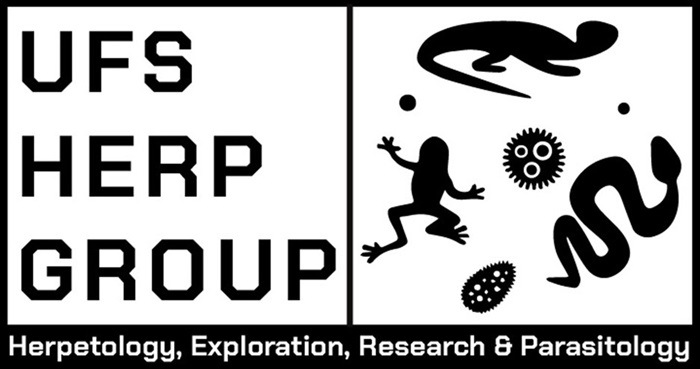
WELCOME MESSAGEWelcome to the UFS HERP Group! Our research group specialises in all things Herpetology (her·pe·tol·o·gy), the scientific study of amphibians and reptiles. With a specific focus on understanding the complex interactions between herpetofauna and their habitats, parasites, and one another. Led by Dr Edward C. Netherlands, our team dedicates ourselves to advancing scientific knowledge and fostering the next generation of researchers. With over 550 herpetofauna species in South Africa alone spread across the crocodilian, snake, lizard, chameleon, frog, toad, tortoise, terrapin, and turtle taxa there is a world of information to be uncovered about these organisms.
We invite you to explore our website to learn more about our ongoing projects, recent field trips, and the diverse research interests of our members. Through our work, we aim to bridge the gap between science and society, engaging with the community through educational outreach and collaborative efforts.
MEET THE TEAMGroup Head
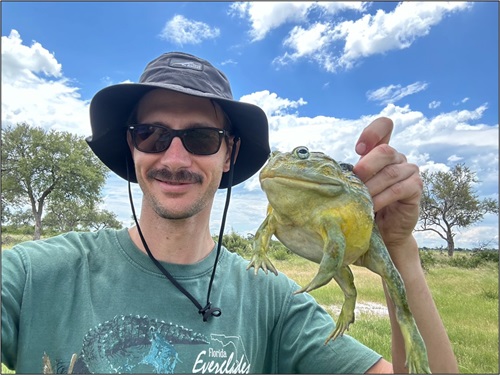
Ed Netherlands holding a specimen of the recently described Pyxicephalus beytelli from Namibia, 2024.
Dr Edward Netherlands A herpetologist and parasitologist with over 15 years of experience studying blood parasites, mainly in ectotherm hosts. He focuses on the diversity, life history, and interactions of these parasites with their hosts and vectors.
Dr Netherlands is dedicated to mentoring future scientists, having supervised many students who now hold successful careers in academia and industry. His work has significantly advanced the understanding of blood parasite biology and its effects on reptile and amphibian hosts.
His expertise spans parasitology, ecology, conservation biology, biodiversity, and molecular and evolutionary biology. He is involved in multiple national and international research collaborations, values community engagement, and regularly gives lectures and workshops to school children, aiming to bridge the gap between science and society.
PhD Students
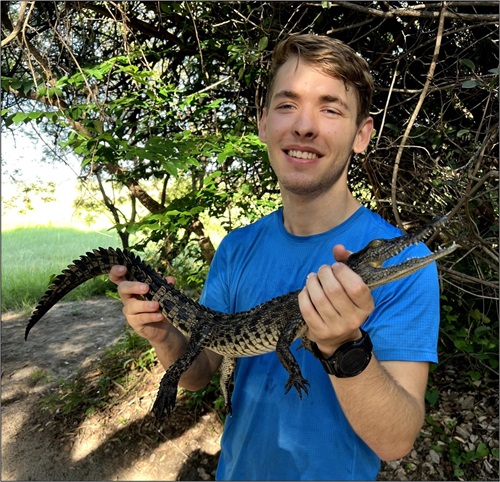
Bernie Jordaan holding a juvenile Crocodylus niloticus collected in nothern Namibia, 2024
Bernard JordaanBernard (Bernie) Jordaan completed his Masters degree at North-West University in 2022. He started his PhD project under Dr. Edward Netherlands in 2023 at the University of the Free State. The project involves looking at the trypanosomes of amphibians and reptiles from a systematic, ecological, morphological, and molecular perspective. Some examples of the work he is actively involved in are field sampling of herpetofauna, microscopic analysis of blood smear slides, and molecular characterisation of specimens. He is currently a guest student at the Department of Bioinformatics and Biotechnology at the University of Pavia, Italy (April 2024-October) as part of an exchange program with a focus on Next Generation Taxonomy and Genomics
-south-africa.jpg?sfvrsn=36930620_3&MaxWidth=500&MaxHeight=500&ScaleUp=false&Quality=High&Method=ResizeFitToAreaArguments&Signature=058712033E5FF6EF8C090C5877DAD7A540198E66)
James Kidd handling a dangerous Mole Snake ( Pseudaspis cana), South Africa,2022
James KiddOriginally a graduate of UKZN, James moved to Bloemfontein to continue his postgraduate studies in 2020. Having completed his Honours (2020) and Masters (2023) Degrees in Zoology, focussing on Herpetology, at UFS he has accrued a solid knowledge and skill base in the herpetological field. His specimen group of focus is Agamid Lizards although he also has experience with other hepetofaunal groups such as frogs and snakes. His research is focused mainly on general and reproductive ecology and taxonomy while also delving into the fields of parasitology and molecular biology.
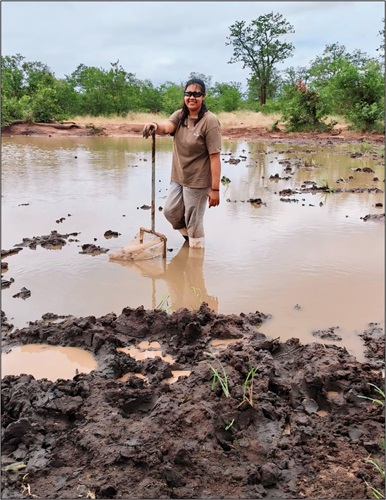
Nikisha Singh sampling in a muddy water body for tadpoles in Kruger National Park,2024
Nikisha SinghNikisha Singh is currently employed by SANParks, Kruger National Park as the curator of the invaluable Skukuza Biological Reference Collection, which comprises ~25000 floral and faunal specimens. She holds an MSc in Biological Sciences (2020) from the University of KwaZulu-Natal which predominantly focused on aspects of the biology and ecology of the Southern Tree Agama (
Acanthocercus atricollis) in an urban context. Collection care and curation, educational facilitation, biodiversity data management, and research support form part of her current duties, while her research interests lie in herpetology, conservation, and freshwater systems. She is currently pursuing a PhD which will aim to bridge some of the knowledge gaps that exist concerning amphibian and tadpole diversity and conservation in the Kruger National Park.
.jpg?sfvrsn=3b930620_3&MaxWidth=500&MaxHeight=500&ScaleUp=false&Quality=High&Method=ResizeFitToAreaArguments&Signature=0165AF1001678F5B92A8AFAD8D26A24535035B90)
Monique Barnard observes a captured Beaked Blind Snake ( Rhinotyphlops lalandei), South Africa 2023
Monique BarnardBorn and raised in Bloemfontein, Monique completed her undergraduate (2022) and Honours (2023) degrees at the University of the Free State. With a background in animal ecology (accumulated during her Honours studies), she hopes to take on the world of herpetology by storm. She is currently busy with her Masters project, in which she aims to determine the diversity of the different species of
Haemogregarina (Protozoan blood-parasites) infecting freshwater terrapins in Southern Africa and the Americas, with a focus on differences in taxonomy and ecology.
.jpg?sfvrsn=d3970620_3&MaxWidth=500&MaxHeight=500&ScaleUp=false&Quality=High&Method=ResizeFitToAreaArguments&Signature=1301400E18FF8E91AAF68BC17EF171EC9310A8C3)
Mlando Dlomo holds a Giant African Bullfrog ( Pyxicephalus adspersus), South Africa,2021
Mlando DlomoMlando Dlomo, originally from KwaZulu Natal (Greytown) but is currently based in Johannesburg at the Johannesburg Zoo where he works as a reptile curator. He has a Diploma & Advanced Diploma in Nature Conservation and BSc Honours in Environmental Management, all acquired through UNISA. He will be starting his MSc majoring in Zoology at the University of the Free State in July 2024.
His research will be on Scelotes inornatus particularly using specimens housed at the Johannesburg Zoo. The focus of the study would be on identifying environmental parameters ideal for survival and breeding of
Scelotes inornatus in captivity.
He has worked within reptiles, amphibians as well as tarantulas during his time working at both the Pretoria Zoo (2017-2021) and Johannesburg Zoo.
Of particular interest is his work on the Amphibian Research Project (ARP) which focuses on captive care and breeding of Pickersgill’s Reed Frogs (
Hyperolius pickersgilli) and Durban Dwarf Burrowing Skink (
Scelotes inornatus).
.jpg?sfvrsn=4930620_3&MaxWidth=500&MaxHeight=500&ScaleUp=false&Quality=High&Method=ResizeFitToAreaArguments&Signature=30B0390BEBBAD3CBEF927CF2183D09CA56E18C3C)
Pieter Jansen poses with a Cape Cobra ( Naja nivea) South Africa,2023
Pieter JansenPieter completed his undergraduate degree at the North-West University and subsequent Honours degree at the University of the Free State. He is currently employed at Sasol: Land and Biodiversity as an environmental consultant assisting in research and biodiversity surveys. His MSc project focuses on ectoparasites, mainly ticks, from Servals (
Leptailurus serval). With little knowledge regarding parasites from servals, it is a great opportunity to investigate which parasites these spectacular cats are hosting and whether certain factors (age, sex, body condition) of the servals influence the tick load. He has been privileged to be part of the serval research for the last five years and hopes to build upon his experiences and knowledge even more.
Hons Students
RESEARCH FOCUSIn the UFS HERP Group, our research spans four key areas:HerpetologyWe study the biology, ecology, and conservation of reptiles and amphibians. Our research includes understanding species diversity, behaviour, and the environmental factors affecting these animals.
ExplorationFieldwork and expeditions are crucial to our research. We conduct extensive field studies to gather data on herpetofauna in their natural habitats, discover new species, and document their interactions with the environment.
ResearchOur lab focuses on cutting-edge research in parasitology, ecology, conservation, biodiversity, and molecular and evolutionary biology. We use modern techniques and equipment to generate the best output of information with the aim of publishing high-quality research.
ParasitologyWe investigate the diversity, life cycles, and interactions of parasites with their reptile and amphibian hosts. Our research seeks to understand how these parasites affect their hosts' health and the broader ecological implications.
Our interdisciplinary approach and collaborative efforts help us address complex scientific questions and contribute to conserving herpetofauna and their ecosystems.Current Student Research Projects
“A multi-faceted taxonomic review for resolving the ground Agama complex in Southern Africa” – James Kidd
“Identifying environmental parameters ideal for survival and breeding of Scelotes inornatus in captivity” – Mlando Dlomo
“In cold blood: freshwater terrapins and their associated species of Haemogregarina” – Monique Barnard
“Tadpole and Frog Diversity in the Kruger National Park and their Conservation Outlook” – Nikisha Singh
“Trypanosomes (Kinetoplastea: Trypanosomatida) of Southern African herpetofauna: An ecological, evolutionary, and systematics investigation” – Bernie Jordaan
RECENT EXCURSIONSNamibia & Botswana, January-February 2024
Members of the UFS HERP Group (Dr. Ed Netherlands, Bernie Jordaan, and James Kidd), along with research colleagues from the AACRG, NWU (led by Prof. Louis du Preez), The Windhoek Museum, and Auburn University, USA, undertook a month-long research trip across southern Africa. The primary aim of the trip was to collect and document the diversity of herpetofauna and their associated parasites while also gathering data for various postgraduate students’ projects. The trip was a resounding success, with the team recording a high number of species, including several range extensions. Notable captures included multiple specimens of
Pyxicephalus beytelli, a newly described species of African bullfrog, as well as some interesting species such as the Spotted Barking gecko (
Ptenopus garrulus); Eastern Tiger Snake (
Telescopus semiannulatus); Banded Rubber Frog (
Phrynomantis bifaciatus) and the Okavango Mud Turtle (
Pelusios bechuanicus).
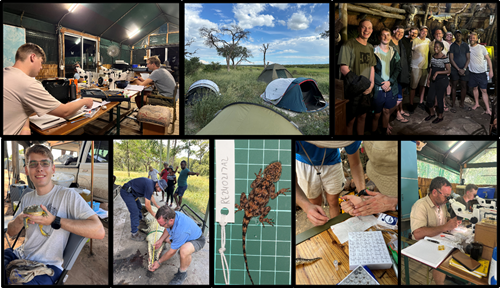
Herpetology field trips and excursions
A collection of photographs from the Namibia & Botswana trip, 2024. From top left: Field lab in Botswana; Camping in the Khaudom, Namibia; Group photo at the Mahangu Lodge bar; Bernie Jordaan holding a
Pyxicephalus adspersus; Dr. Francois Jacobs (KIFI) and Prof. Loius Du Preez (NWU) measure a Nile crocodile,
Crocodylus niloticus; A specimen photo of a juvenile
Agama atra; Bernie Jordaan and Dr. Ed Netherlands making blood smears from a Puff Adder,
Bitis arietans; Xenopus dissections at the field lab, Botswana.
Bankfontein Honours Herpetology Excursion, February 2024
Each year the UFS Department of Zoology and Entomology honours class goes on a week-long field excursion to hone their fieldwork skills. The course is overseen by the UFS HERP Group, and as such, the fieldwork aspect leans towards herpetofauna. The students employ terrestrial and aquatic sampling techniques that are both passive (song meters, traps, drift fences, etc.) and active (netting, hand capture, noosing, etc.), intending to catch and identify as large a proportion of the local herpetofauna species as possible while utilising newly learned field techniques.
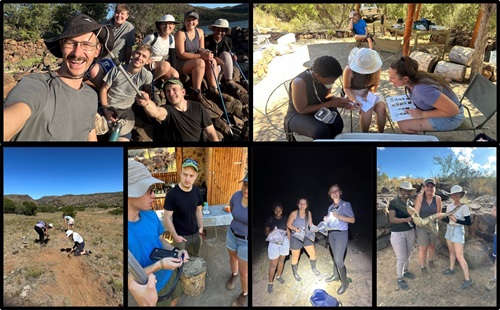
A collection of photographs from the Bankfontein Honours Herpetology Excursion, 2024. From top left: The 2024 Group; The students using taxonomic keys to identify frog species; The students setting up a drift fence and pitfall traps; Bernie explains to the students about sexing snake species; A successful frogging evening; The “Big Catch” of the trip,
Varanus niloticus, held aloft by the students.
Community Frogging Evenings, 2023 & 2024
Members of the UFS HERP Group have been actively involved in community projects to educate young children (and often their parents) about the diversity of frogs in South Africa, particularly in Bloemfontein. These events, known as "Frogging Evenings," are held mostly in the evening, so we can have fun catching frogs with the kids. The group begins the educational portion of the evening with a short presentation, often in both English and Afrikaans to accommodate the various home languages of the attending children. They discuss the fascinating lives of frogs and the many species that can be found. The excitement reaches its peak when, after the informative talk, the kids are let loose with nets and plastic bags to catch and identify as many frog species as possible. Any frogs captured are brought back to the UFS HERP team for identification and more educational fun facts.
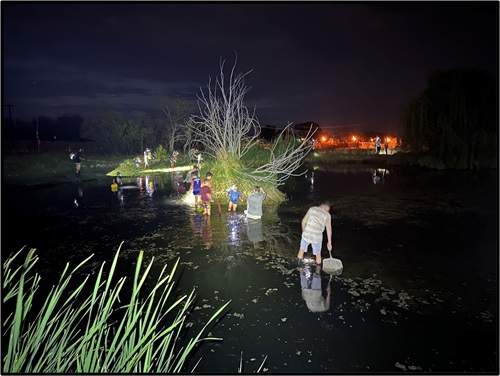
Kids who attended one of the frogging information evenings wade in a small dam attempting to catch different frog species, Bloemfontein, 2023.
CONTACT US
Dr Edward Netherlands, Group Head
Tel: + 27 51 401 7585
NetherlandsEC@ufs.ac.zaOffice: Biology Building (6): Department: Zoology and Entomology: Room 117
Lab Location: Biology Building (6): Department: Zoology and Entomology
https://maps.app.goo.gl/Hq9ZbXi7ZyRvp8nD9